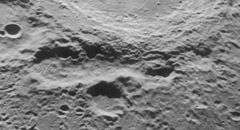Palitzsch (crater)
Palitzsch is a lunar impact crater that is located in the southeast part of the Moon, near the southeast rim of the crater Petavius. Just to the southwest of Palitzsch is Hase, while to the east-southeast is Legendre.
 Oblique Lunar Orbiter 4 image, facing west | |
| Coordinates | 28.0°S 64.5°E |
|---|---|
| Diameter | 41 km |
| Depth | Unknown |
| Colongitude | 296° at sunrise |
| Eponym | Johann G. Palitzsch |
The northeast rim of Palitzsch forms the southern end of Vallis Palitzsch, a lunar valley that follows the eastern rim of Petavius for a distance of about 110 kilometers. The crater rim is relatively low and inconspicuous, while the floor forms a depression in the surface that follows the contours of the neighboring valley.
Satellite craters
By convention these features are identified on lunar maps by placing the letter on the side of the crater midpoint that is closest to Palitzsch.
| Palitzsch | Latitude | Longitude | Diameter |
|---|---|---|---|
| A | 26.9° S | 65.8° E | 31 km |
| B | 26.4° S | 68.4° E | 39 km |
Due to its rays, Palitzsch B is mapped as part of the Copernican System.[1]
References
- Andersson, L. E.; Whitaker, E. A. (1982). NASA Catalogue of Lunar Nomenclature. NASA RP-1097.CS1 maint: ref=harv (link)
- Blue, Jennifer (July 25, 2007). "Gazetteer of Planetary Nomenclature". USGS. Retrieved 2007-08-05.CS1 maint: ref=harv (link)
- Bussey, B.; Spudis, P. (2004). The Clementine Atlas of the Moon. New York: Cambridge University Press. ISBN 978-0-521-81528-4.CS1 maint: ref=harv (link)
- Cocks, Elijah E.; Cocks, Josiah C. (1995). Who's Who on the Moon: A Biographical Dictionary of Lunar Nomenclature. Tudor Publishers. ISBN 978-0-936389-27-1.CS1 maint: ref=harv (link)
- McDowell, Jonathan (July 15, 2007). "Lunar Nomenclature". Jonathan's Space Report. Retrieved 2007-10-24.CS1 maint: ref=harv (link)
- Menzel, D. H.; Minnaert, M.; Levin, B.; Dollfus, A.; Bell, B. (1971). "Report on Lunar Nomenclature by the Working Group of Commission 17 of the IAU". Space Science Reviews. 12 (2): 136–186. Bibcode:1971SSRv...12..136M. doi:10.1007/BF00171763.CS1 maint: ref=harv (link)
- Moore, Patrick (2001). On the Moon. Sterling Publishing Co. ISBN 978-0-304-35469-6.CS1 maint: ref=harv (link)
- Price, Fred W. (1988). The Moon Observer's Handbook. Cambridge University Press. ISBN 978-0-521-33500-3.CS1 maint: ref=harv (link)
- Rükl, Antonín (1990). Atlas of the Moon. Kalmbach Books. ISBN 978-0-913135-17-4.CS1 maint: ref=harv (link)
- Webb, Rev. T. W. (1962). Celestial Objects for Common Telescopes (6th revised ed.). Dover. ISBN 978-0-486-20917-3.CS1 maint: ref=harv (link)
- Whitaker, Ewen A. (1999). Mapping and Naming the Moon. Cambridge University Press. ISBN 978-0-521-62248-6.CS1 maint: ref=harv (link)
- Wlasuk, Peter T. (2000). Observing the Moon. Springer. ISBN 978-1-85233-193-1.CS1 maint: ref=harv (link)